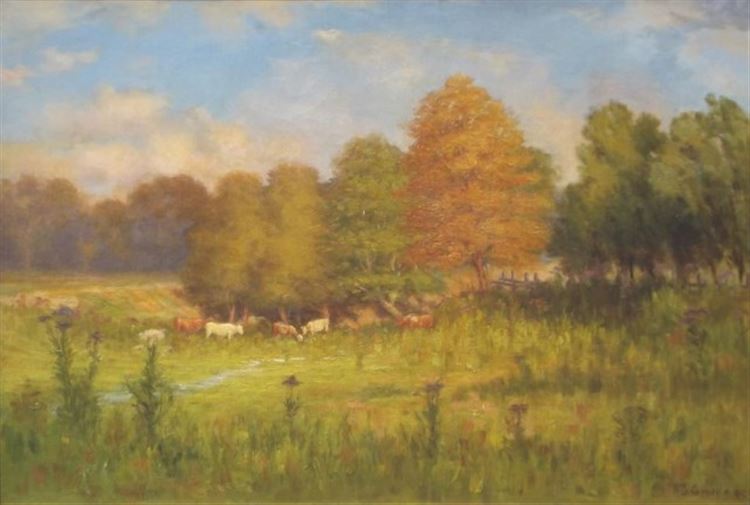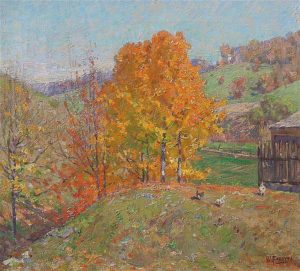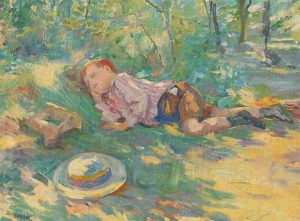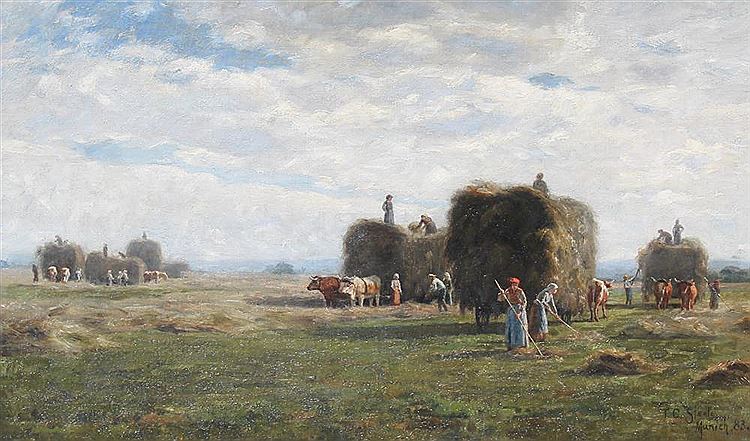When Art of Estates, an art and personal property appraisal firm appraises collections throughout the state of Indiana, we frequently come across works by notable and historical artists from the region. Amongst these historically significant artists in Indiana is the Hoosier Group. The Hoosier Group was a group of artists dedicated to capturing the beauty of the Indiana landscape through the new aesthetics of the Impressionist movement. They came together at an important time in Indiana’s history and provided the state with a lively dosage of art culture and new ideas. The members of the group have given Indiana a treasured array of artworks that continue to inspire Indiana residents today.
The Midwestern States Grow as Settlers Move from the East Coast
The Midwestern United States was the site of tremendous growth in the early 1800s as settlers moved from the Eastern cities to the frontier in hopes of making it rich and getting out of the crowded, polluted cities on the Atlantic. Cincinnati was one of the first great cities to rise out of the province known as the Northwest Territory, a land that was owned first by the French and then the British before being ceded to the colonialists after the War of Independence. As settlers continued to move West towards the frontier new settlements were made in what was previously known as the Indiana Land Company. This area was eventually called Indiana or the “Land of the Indians.” In 1812 Jonathan Jennings, the territories representative to Congress proposed for the territory to be granted statehood. The territory was well below the population quota required by Congress to establish a state, but due to the outbreak of the War of 1812, no objections were raised to the proposal. Thus, the state of Indiana was born, and with it a long history of traditions, politicians, business leaders, teachers, lawyers, merchants, accountants, writers, musicians, and of course – artists.
Impressionism Develops in Paris, Influencing American Artists
The mid-19th century saw many exciting developments in the world of art and culture. Painters, writers, and musicians in America and Europe were experimenting with new forms. One of these new movements was Impressionism. Impressionism as an art movement originated in France. The process that the painters used was focused on depicting the changing characteristics of light and generally featured short, colorful brushstrokes. This movement was in stark contrast to the officially preferred art of the Paris Salon. The Salon was an organization in Paris that had a monumental sway in the art world for French society. Jurors at the Salon preferred historical subjects and portraits that were carefully rendered. The Impressionists eventually found exposure through the Salon des Refuses, an alternative Salon in which the works rejected from the yearly Salon exhibition would be shown. It was after this that the Impressionists gradually found more and more favor with the public. Eventually, their ideas would spread internationally, and American artists were soon painting in the manner of the Impressionists.
The Hoosier Group Gains Notoriety as Quintessential American Artists
The Hoosier Group was a group of five artists; T. C. Steele, Richard Gruelle, William Forsyth, J. Ottis Adams, and Otto Stark. These artists were well known in Indiana and eventually around America for their Impressionist style of painting and their capturing of the Indiana landscape. However, what truly brought the artists together was their determination to attend art school in Munich in the late 1880s. Their training in Europe would allow them to hold precedence over the art community in Indiana after their return. The group of artists was found to be working in Indiana at a great time for the state. The turn of the century saw Indianapolis flourishing with many new businesses forming such as pharmaceuticals and the auto industry. Since many of these businesses were locally owned, the city benefited from patronage by the rising wealthy class of fine art appreciators who dotted the city.

T. C. Steele Emerges as a Well-Known Artist from Indiana & The Hoosier Group
T. C. Steele is regarded as one of the most well-known Indiana artists of all time. Born on September 11, 1847, the artist’s father was a saddlemaker and farmer. Upon the death of his father, Steele was tasked with the job of supporting his family. His mother, however seeing his passion for art eventually freed him of his duties so that he could pursue a career as an artist. Steele received training at the Waveland Collegiate Institute and then furthered his studies at Asbury College when he was sixteen.
By the time he was eighteen, Steele was teaching painting courses at the Waveland Collegiate Institute. Steele married Mary Elizabeth (Libby) Lakin in 1870. A son and a daughter were born to the couple in 1870 and 1872, respectively. Libby died in 1899 after which Steel married Selma Laura Neaubacher in 1907. Of significance in the artist’s life was Steele’s decision to study in Munich due to the presence of a prominent Ohio painter by the name of Frank Duvenek. He also studied under Gyula Benczur and Ludwig Lofftz. The artist found support from wealthy patrons in Indianapolis who had been asked to raise funds by Herman Lieber.
Upon his return to Indianapolis Steele rented a large home on Sixteenth Street. The artist originally kept a studio downtown where he sold his works but eventually decided to have a studio built on his property. The studio on Sixteenth Street became a gathering point for many Indiana artists of the time. Steele gradually shifted his style upon his return to Indiana from the classic Munich dark-toned somber paintings to a more colorful lighthearted pallet. He was specifically concerned with portraying the beauty of the state of Indiana.
Steele’s second wife Selma would later be known as a fundamental component of Steel’s productivity as she maintained the couple’s property until the artist’s death. The property was known as the House of the Singing Winds due to how the wind would blow into the house through the door screens. Like his studio on Sixteenth Street, the house was a gathering point for many Indiana artists.
Richard Gruelle Gains Connections in the Capitol and Shows with the Hoosier Group
Richard Gruelle was a landscape painter and notably one of the five members of the Hoosier Group. He was the only one in the group to not receive European training. The artist was born in Kentucky to John Gruelle and Prudence Gruelle. The boy went with his family to Illinois to settle when he was a young child. When he was an adolescent, he went to work with a sign painter to help support his family. It was in this environment that he was able to teach himself some fundamentals of art.
Eventually tiring of working in the house painting industry, Gruelle set to painting portraits of the recently deceased in his small town of Arcola. He eventually moved to Decatur, Illinois to establish an art practice. It was here that he earned a steady income for a time through, among other things, teaching art lessons. He married Alice Benton here, and the two moved to Cincinnati, Ohio. Upon his father’s death, he returned to Arcola, then for a brief time lived in Florida, before finally settling in Indianapolis. It was here in Indianapolis that the artist was asked by James Whitcomb Riley to illustrate the poems When the Frost is on the Punkin and “The Old Swimmin’ Hole.”
Eventually, Gruelle was able to with the help of a friend gain a connection to the U.S. Capitol in Washington. It was at this location that the artist painted and exhibited his work. Through this experience, he developed relationships with wealthy patrons on the East Coast, something that would influence his later decisions. During his stay in the east Gruelle was connected to the rich industrialist William Walters who owned a large collection near Baltimore, Maryland. He was able to look at the works of the great masters on the east coast as well, something that helped him refine his painting skills even more.

In December of 1894, Gruelle was included with William Forsyth, Otto Stark, J. Ottis Adams, and T. C. Steele as part of the “Hoosier Five.” They exhibited in a group show together in Chicago and were given stellar reviews, which eventually led to recognition for all of them.
In 1905 Gruelle left for New York City, taking his family with him. However, he and his wife did not suit well in the city, and they left after a year. Their children would remain in the big city to pursue their artistic ambitions as they felt that New York had many more opportunities than Indianapolis. Eventually drawn by the fact that his children were on the east coast, Gruelle returned to the area in 1910, settling near Norwalk, Connecticut.
William Forsyth Leads a Promising Career after Studying in Europe
William Forsyth was an American Impressionist painter who was born on October 15, 1854, in California, Ohio. His family would transition their lives to Indiana when he was a young boy. As a child, he sketched when he was able to. However, he had no formal training, but this changed in 1877 when he was finally able to enroll as one of the first students in the Indiana School of Art in Indianapolis. The school would close down a couple of years later, but Forsyth would continue to paint around the Indianapolis area with other former students of the institution. In 1881 the artist was allowed to study abroad in Europe. Forsyth would choose Germany as a region to study in because other artists from the United States were training there as well as the fact that T. C. Steele, a well-known Indiana artist, was working at the academy at the time. The artist would finish his journey to Munich in 1882 and be accepted to the academy within a few months of him entering the city. Forsyth distinguished himself during his time at the academy and received an award in a student exhibition in 1885. He completed his studies in 1886.

Forsyth would return to Indiana in 1888 where he first settled in Fort Wayne, followed by Muncie. It would be in 1894 that the artist submitted to the career-defining art exhibit that would travel to Chicago where his critics would name him as one of the members of the “Hoosier Group.” Forsyth would go on to join the faculty of the John Herron Art Institute in 1906 where he would work for around 30 years. The artist was fired in 1933 as the school was forced to fire many of its well-known faculty due to the Depression.
Otto Stark Studies in Paris and Returns to Indiana to Teach
Otto Stark was a painter and member of the Hoosier Group who was born on January 29, 1859, in Indianapolis, Indiana. The artist started to train to be a lithographer in 1875. He would move to Cincinnati, Ohio where he apprenticed himself to a lithographer there. While living and working in Cincinnati, the young Stark began taking classes at the University of Cincinnati-affiliated Art Academy of Cincinnati. The artist would eventually move to New York City in 1879 to continue his studies at the Art Students League of New York, where he learned classical techniques for art-making. He supported his studies and lifestyle while he was in New York by working as a lithographer. His studies in New York would be followed by his studies in Paris, France when in 1885 he enrolled as a student at Academie Julien. He would return to New York City in 1887.
Stark would work in both New York City and Philadelphia for several years while living with his French wife and raising his family of four children. When his wife died in 1891, the artist would return to Indianapolis with his family so that his father and sister could help with the raising of his family. The artist would go on to begin working for the Emmerich Manual High School in Indianapolis as a supervisor of art in 1899.
Stark would be granted an honoree membership at what would later become the Indianapolis Museum of Art in 1898. He would also become a member of the Society of Western Artists, a group founded by members of the Hoosier Group, in 1897. The artist would be included in several exhibitions throughout America and the world. These include being shown at the Louisiana Purchase Exposition in 1904. Stark died in April 1926.
John Ottis Adams Studies Abroad and Goes on to Found the Indianapolis Museum of Art
John Ottis Adams was born in 1851 in Amity, Indiana. His family would move to different areas often during his childhood, and the young boy held an inclination towards art-making from these times. The artist would enroll at Wabash College in Crawfordsville, Indiana, in 1871. However, after just two years he left school. The artist would go on to pursue an education at the South Kensington School in one of the most important cities in the world at that time: London. Upon finishing his studies, the artist made his way back to Indiana, this time settling in the town of Muncie. It was there that he set up his professional art practice for four years, frequently painting the most prominent families in town.
After these four years, the artist decided to return to Europe in 1880. Adams had the intention of studying at the Royal Academy in Munich. The artist departed from New York City to Europe with fellow Indiana artists T. C. Steele and Samuel Richards. It was in Munich that Adams would go on to meet Hoosier artist William Forsyth as well. Adams would first enroll in the school of drawing at the Academy before he was admitted to the main school of painting. He studied at the Royal Academy in Munich for a total of five years. After this period, he set up a studio in Munich, although he would also venture to the surrounding area to paint outdoors.
 The artist would leave Germany in 1887 to return to Muncie, Indiana. He would go on to teach courses in Muncie and set up a studio in the town for the next ten years. With the support of local business people, Adams and Forsyth in 1889 formed a school in Muncie known as the Muncie Art School. Unfortunately, the school would go on to close in 1891.
The artist would leave Germany in 1887 to return to Muncie, Indiana. He would go on to teach courses in Muncie and set up a studio in the town for the next ten years. With the support of local business people, Adams and Forsyth in 1889 formed a school in Muncie known as the Muncie Art School. Unfortunately, the school would go on to close in 1891.
In 1894 Adams submitted to the Chicago-based group show Five Hoosier Painters. It was from this association that they would be recognized as the Hoosier group.
Adams was among the founding members of the John Herron School of Art. The art school would later become known as the Indianapolis Museum of Art (now known as Newfield’s). The artist would leave the institute in 1906. He spent his later years traveling back and forth from Indiana to Florida. The artist would die in his home on January 28, 1927.
If you are seeking or in need of an art appraisal by an Indiana Hoosier Group artist, please contact us through our appraisal online form or give Art of Estates a call about your appraisal needs.


